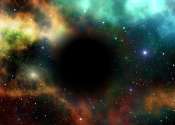Disks, spikes and clouds: A peek into a black hole's back yard
The first direct detection of gravitational waves in 2015 has opened a new window on the universe, enabling in particular the observation of the merger of pairs of massive black holes. This young field of research has matured ...









